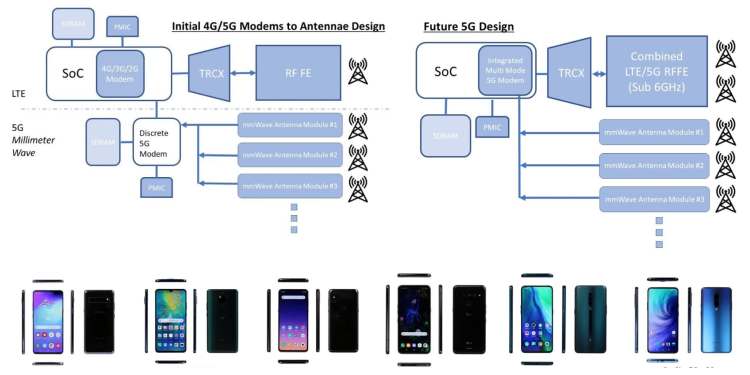While an iFixit teardown of Huawei’s Mate 20X suggested that the company’s first 5G smartphone was using fairly large, hot-running components to compete with Qualcomm’s Snapdragon chips, the engineering differences between the 5G rivals are now becoming clearer thanks to teardowns performed by IHS Markit. In a report released today, the research firm says it made some interesting discoveries after disassembling six early 5G smartphones: Based on chip size, system design, and memory, Huawei rushed an comparatively inefficient solution to market, resulting in a device that’s larger, more expensive, and less energy efficient than it could have been.
Huawei made a fairly big deal about its use of self-made processors in its 5G phones, noting that it was including both a Kirin 980 system-on-chip and a Balong 5000 5G modem, the latter billed as the first commercial multimode 5G/4G/3G/2G chip. In theory, that modem should have given the Mate 20X an advantage over devices with early Snapdragon chips, but as IHS notes, the Kirin 980 has its own 4G/3G/2G modem inside, which wound up “unused and unnecessary” inside the phone, increasing its cost, battery usage, and PCB footprint.
The space savings from a smaller SoC wouldn’t have been trivial, and was compounded by related component inefficiencies: a Huawei modem die size 50% larger than Qualcomm’s first-generation X50 modem, a “surprisingly large” 3GB of supporting memory just for the modem, and a lack of support for millimeter wave 5G networks. By comparison, IHS principal analyst Wayne Lam told VentureBeat, Samsung’s Exynos 5100 modem die size is “almost exactly the same as the X50.” The report describes Huawei’s design choices as “far from ideal,” noting that they’re “highlighting the challenges of early 5G technology.”
Despite those issues, IHS noted that Huawei’s reliance on one 5G/4G/3G/2G modem rather than two separate 5G and 4G/3G/2G modems is the way forward, as it enables convergence of both the modem and related parts such as radio-tuning RF front ends and radio antennas. The Mate 20X has separate 4G and 5G radio tuners, but over time, those parts will become more integrated as well, resulting in greater power efficiency. Qualcomm is expected to be the only real alternative for carriers and OEMs interested in supporting millimeter wave 5G, as it’s already offering complete modem-to-antenna designs; its only multi-vendor rival, MediaTek, has focused on non-millimeter wave parts.
June 5th: The AI Audit in NYC
Join us next week in NYC to engage with top executive leaders, delving into strategies for auditing AI models to ensure fairness, optimal performance, and ethical compliance across diverse organizations. Secure your attendance for this exclusive invite-only event.
IHS expects that the next step — integration of 5G/4G/3G/2G multimode modems directly inside smartphone SoC processors — will take place in 2020, eliminating the need for a separate modem while “significantly” cutting related component costs by eliminating the need for separate modem RAM and power management chips. MediaTek has already announced such a chip for 2020 devices as the 5G SoC, minus millimeter wave, but competitors will likely include a more integrated RF front end with full support for both millimeter wave and sub-6GHz 5G, enabling “better, cheaper, and faster 5G smartphones” to come to market over the next year.

